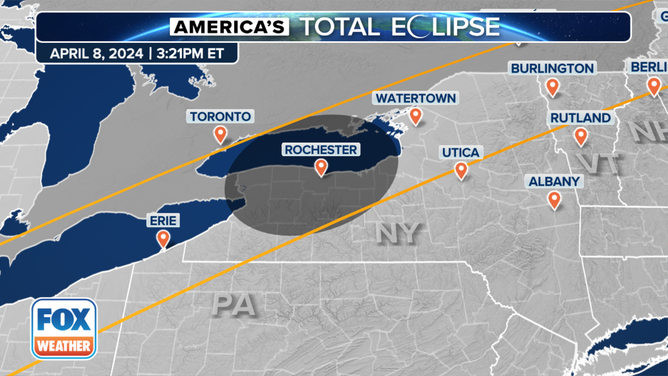On Monday, April 8, a total solar eclipse will plunge parts of 15 U.S. states into sudden darkness as the moon’s enormous shadow sweeps across the continent.

Crossing northeast from Mexico to Canada over the course of several hours, the April 8 total solar eclipse will be visible to an estimated 44 million people who live in the path of totality — the path of the moon’s shadow, and the only place where the total phase of the eclipse will be visible — while a partial eclipse will be visible across nearly the entire U.S.
Here’s everything you need to know about solar eclipses, and how to safely view the spectacular celestial event on April 8 safely.
Here’s what you need to know about viewing the eclipse in New York.

What is a total solar eclipse?
A total solar eclipse happens when the Moon passes between the Sun and the Earth, completely blocking the face of the Sun for several minutes.
From partial eclipse through totality, the process takes several hours. The final moments before totality include displays of light known as Baily’s Beads and the Diamond Ring caused by the pock-marked surface of the Moon.
Where can I see the total solar eclipse in New York?
The maximum total solar eclipse known as totality will be visible across a section of the state from the southwest corner of New York to the Canadian and Vermont borders.
This will be the first total solar eclipse for New York in 99 years.
Totality will cast a dusk-like shadow on the cities of Buffalo, Rochester, Niagara Falls, Syracuse, Watertown and Massena.
Before the eclipse moves into Vermont, New York’s Adirondacks region will be the last to see a total solar eclipse. Areas including Blue Mountain Lake, Indian Lake, Lake Placid and Jay Village will be in the path of totality.
A partial eclipse will be visible across the entire state of New York, including nearly 87% in New York City. Areas just outside the path of totality such as Utica will see nearly a total eclipse with 99.7% of the Sun covered.

The path of totality through New York on April 8, 2024.
What time is the solar eclipse in 2024?
The first cities in New York to see totality will be near the New York-Pennsylvania state line, including Westfield at 3:17 p.m. with 3 minutes and 42 seconds of totality.
A partial eclipse begins in Buffalo and Niagara Falls at 2:05 p.m. with totality at 3:18 p.m. Buffalo will have 3 minutes and 46 seconds of near darkness.
How to safely view a solar eclipse
It is never safe to gaze directly at the sun, even when it is partly or mostly covered by the moon. Special eclipse glasses or pinhole projectors are required to safely view solar eclipses and prevent eye damage. Failing to take the proper precautions can result in severe eye injury, according to NASA.
Eclipse glasses are thousands of times darker than normal sunglasses and specially made to enable wearers to look at the sun during these kinds of celestial events.
Sky-watchers should also never view any part of the sun through binoculars, telescopes or camera lenses unless they have specific solar filters attached. Eclipse glasses should not be used with these devices, as they will not provide adequate protection.
However, during the few minutes of totality, when the moon is fully blocking the sun, it is safe to look with the naked eye.
When is the next solar eclipse in New York?
After April 8, 2024, parts of New York will have to wait decades for another total solar eclipse. Portions of New York will experience several partial solar eclipses in the coming years, including next year and in 2026.
However, the next total solar eclipse in the U.S. in 2044 will only bring totality to parts of Montana and the Dakotas.
The next total solar eclipse won’t be visible in New York until May 1, 2079, according to timeanddate.com.
